The popular vaudeville team of David Craig Montgomery (1870-1917) & Fred Stone (1873-1959) had come to public acclaim after their roles in the stage musical Wizard of Oz (1903).
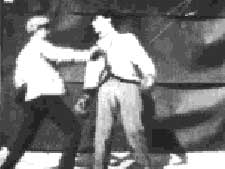 They perform comic boxing in Dancing Boxing Match, Montgomery & Stone (1907) though only a couple seconds survive. This was a routine they worked out for a little stage play called The Red Mill produced in 1906 at the Knickerbocker Theater. They perform comic boxing in Dancing Boxing Match, Montgomery & Stone (1907) though only a couple seconds survive. This was a routine they worked out for a little stage play called The Red Mill produced in 1906 at the Knickerbocker Theater.
There's too little remaining of the film to tell if they were funny. But Fred Stone, who in this surviving fragment jumps head-first to the floor & back to his feet, certainly looks impressively acrobatic.
This was made by the short-lived Winthrop Moving Picture Company, which the Edison Company quickly ran out of business. The company had a scant six known films under their belt, all from the same year, two completely lost, & fragments surviving from four.
The other substantial fragment in poor condition is Marceline, the World-Renowned Clown of the N.Y. Hippodrome (1907). The main importance of this film is that Charlie Chaplin's memoir acknowledged Marceline (born Marcelino Orbes in Saragossa, Spain, in 1873) as his primary influence.
Chaplin had seen the beginnings of his Little Tramp character when Charlie was only eleven years old & saw Marceline perform. A big success in London then in New York, Marceline later fell from the public's grace & worked as one of many Ringling Brothers clowns, committing suicide in 1927.
This is the only moving record of Marceline. Sadly there's not enough remaining of the fragment to assess what it was that so impressed Chaplin as a child.
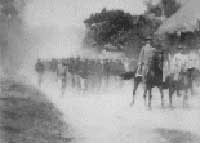 The earliest movies included military parades & war re-enactments, for their dramatic value, pageantry, & newsworthiness.
The earliest movies included military parades & war re-enactments, for their dramatic value, pageantry, & newsworthiness.
Almost pastoral, the 25th Infantry (1902) is shown in parade along a dusty road, first cavalry, then men marching afoot with rifles shouldered, not in uniform but whatever they had to wear.
At the head of the parade are generals Frederick D. Grant & Andrew Sheridan Burt. It was filmed in the Philipines as the 25th Infantry returned from Mt. Ariat.
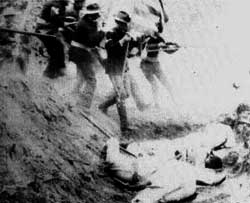 An outdoor location was found to film Capture of Trenches at Candaba (1899) in order to lend authenticity to this short-short scene of Filipino men in a trench firing & reloading rifles, then retreating from the onslaught of American soldiers with prominant flag waving oh so perfectly into the scene. The trench is captured, hoorah hoorah. An outdoor location was found to film Capture of Trenches at Candaba (1899) in order to lend authenticity to this short-short scene of Filipino men in a trench firing & reloading rifles, then retreating from the onslaught of American soldiers with prominant flag waving oh so perfectly into the scene. The trench is captured, hoorah hoorah.
Civil War reenactments made for popular subject matter. Out of the smoke of rifle fire phonied up for Advances of Kansas Volunteers at Caloocan (1899), Confederates march with dramatic determination, aiming their rifles directly at the camera which takes the Union point of view.
As the rebels vanish anew into the thickness of gunpowder smoke, Union soldiers rush them, the Union flag again prominant. A soldier falls with the flag, & another quickly takes it up, & johnny reb is routed.
The Kansas Voluteers were at the time regarded as one of the most heroic of all regiments. This little homage to the famed fighters manages some dramatic tricks well ahead of their time, in the assault directly into the camera, & the smoke FX.
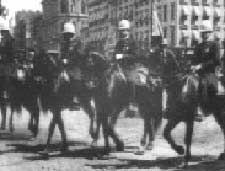 Since the early film industry was centered around New York, it's hardly surprising that the state & the city are so well documented in early documentary filmmaking. New York Police Parade (1899) at two minutes & a pinch shows its subject on 1 June 1899. It is much more than a record of a parade, as it captures a full range of citizenry of a vital city.
Since the early film industry was centered around New York, it's hardly surprising that the state & the city are so well documented in early documentary filmmaking. New York Police Parade (1899) at two minutes & a pinch shows its subject on 1 June 1899. It is much more than a record of a parade, as it captures a full range of citizenry of a vital city.
Fifth Avenue, New York (1897) records a fashion parade down Fifth Avenue. Filming the opposite end of the city's social classes, Move On (1903) at three minutes or so begins with a long shot of street vendors's carts of fruits & vegetables
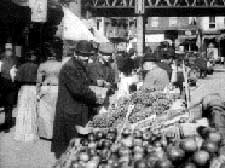 Filmed by Alfred C. Abadie, Move On provides a very simple New York street scene, static but surprisingly action-packed. There's some close-ups & a bit of camera tracking that is advanced for the time. The "climax" is the arrival of a police officer who makes the vendors "move on" while shaking his fist. Filmed by Alfred C. Abadie, Move On provides a very simple New York street scene, static but surprisingly action-packed. There's some close-ups & a bit of camera tracking that is advanced for the time. The "climax" is the arrival of a police officer who makes the vendors "move on" while shaking his fist.
Abadie also filmed Arrival of Emigrants (sic) at Ellis Island; aka, Emigrants Landing at Ellis Island (1906). It begins with images at the Immigration depot on Ellis Island, new arrivals carrying luggage, officials with white sleeves moving among the immigrants.
The first lot actually look like sailors, perhaps ship's laborers, followed by a scruffier lot including children. The horde fills the camera lens near & distant. They board a boat that will take them off the island & in all too many cases, those bags they're holding is everything remaining of their former lives.
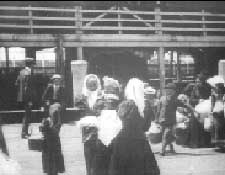 Last of all is a shot of a group from a newly arrived boat disembarking & heading for the immigration depot, that the process may continue. Last of all is a shot of a group from a newly arrived boat disembarking & heading for the immigration depot, that the process may continue.
For a topical subject without story & really more of a newsreel, three & a half minutes was a substantial length of film in 1906, which indicates the popularity of the subject for a city highly populated by immigrants. It required no further commentary or story to be extremely moving to the many thousands who came through Ellis Island.
Mixing sport & regional event subjects, Auto Boat Race on the Hudson (1904) runs about three minutes. It's actually quite startling to see how fast speedboats could go at so early a date, long thin boats of the rowing-team shape but with engines. It was filmed by D. W. Griffith's cinematographer, Billy Bitzer.
Also from Bitzer's camera's eye, Departure of Peary & Roosevelt from New York (1905) is a minor four & a half minute documentary recording Robert E. Peary's departure from New York harbor on the Roosevelt, on the first leg of his expedition in search of the North Pole.
It's very good footage showing the sorts of ships the Roosevelt was moored among. When it shows the deck of the Roosevelt itself, it's quite a crowd saying their farewells to Peary.
Likely this could do be evocative only for whoever has already researched & feels a little of the romance for those old days when it still was possible to be the first person ever to stand in a given part of the world.
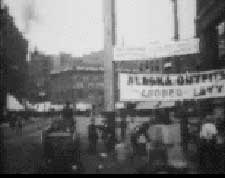 A vast number of New York City films could be reviewed, but there are far fewer films of more distant cities that required more planning & travel to obtain. A vast number of New York City films could be reviewed, but there are far fewer films of more distant cities that required more planning & travel to obtain.
Having myself lived in Seattle for most of my life, I was delighed by First Avenue, Seattle, Washington, No. 8 (1897) which captured a small city with trolly car & seemingly few people, a smoking steamship in Puget Sound, workers on the pier, a four minute window into the past.
The Klondike gold rush was in full sway when James H. White showed up in Seattle, so the First Avenue film shows miners in the street, & an advertising sign for a shop selling mining equipment. Loading Baggage for Klondike, No. 6 (1897) shows the S. S. Willamette in dock, the pier very active with longshoremen, travellers, & pedestrians.
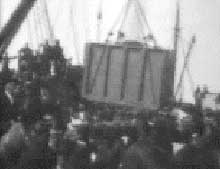 Filmed that same autumn day, Horses Loading for Klondike, No. 9 (1897) with livestock on the pier & horses inside large closed boxes being hoisted onto the deck. Filmed that same autumn day, Horses Loading for Klondike, No. 9 (1897) with livestock on the pier & horses inside large closed boxes being hoisted onto the deck.
It's meant to be viewed along with S. S. "Williamette" Leaving for Klondike (1897), showing the old steamer leaving Seattle, the ship's enormous smokestack prominant.
In the foreground are many people bidding the ship farewell, with even a white hanky waving in air. The title card mispelled Willamette.
Thinking nothing of redundancy, S.S. "Queen" Leaving Dock (1897) shows a large steamer leaving Seattle for the Klondike, with a crowd of miners lined up on deck to watch the city recede.
It's a "sequel" to S. S. "Queen" Loading (1897), showing the steamer close-up, with lots of activity on the pier.
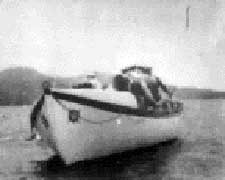 All the Seattle films were produced by James H. White with his camera man Frederick Blechynden. This film journey also took them to San Francisco. The 1896 San Francisco & 1897 Seattle films were part of the same Northern Pacific Railroad Series funded by the railway system. All the Seattle films were produced by James H. White with his camera man Frederick Blechynden. This film journey also took them to San Francisco. The 1896 San Francisco & 1897 Seattle films were part of the same Northern Pacific Railroad Series funded by the railway system.
Later 1897 & 1898 a second filming journey was funded by the Southern Pacific Company series resulted in additional films from White & Blechynden of San Francisco scenes. Raymond Ackerman was filming in the city in 1900, & H. J. Miles in 1903, & most especially Billy Bitzer would make the journey in 1906 for films of the Great Earthquake & San Francisco Fire. The earlier films are more about typical life in the most important western city.
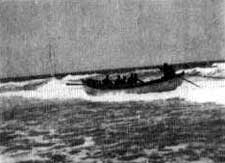 Return of Lifeboat (1986) by White & Blenchynden shows a boat from the Pacific Coast Life Saving Service. Return of Lifeboat (1986) by White & Blenchynden shows a boat from the Pacific Coast Life Saving Service.
More thrilling is their Capsize of Lifeboat (1897), part of a training exercise with the crowded boat intentionally tipped over & righted.
Many more citations could be made for James White's apparent fixation on boats & ships, but I got tired of even watching those.
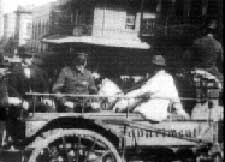 Rather prettier was Parade of Chinese (1898). It captures a lively moment in Chinatown during the San Francisco Golden Jubilee. Floats, banners, & white horses are glimpsed. Rather prettier was Parade of Chinese (1898). It captures a lively moment in Chinatown during the San Francisco Golden Jubilee. Floats, banners, & white horses are glimpsed.
More surprising from the 1897 journey is Arrest in Chinatown which conveys just how audacious the police authorities could be. They've clearly arranged with Edison Company photographers to be filmed arresting a Chinese man.
As the unknown alleged criminal is carted away on a horse-drawn wagon, pedestrians watch, & one of the police officers waves proudly at the camera. Perhaps someone should add a soundtrack to this one which goes "Bad boys, bad boys, whatcha gonna do. Watcha gonna do when they come for you."
One of the more incredible San Francisco early documentary shorts was probably filmed by H. J. Miles though uncredited because he was supposed to be turning over all his films not to the Edison company, but to the American Mutoscope & Biograph Company.
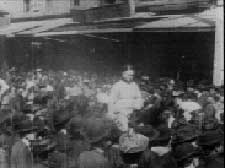 I could be assuming wrong but Edison was notorioius for poaching who & what he could in all spheres of the company, & Miles had a particular eye for ornateness of city streets that seems to be reflected in San Francisco Chinese Funeral (1903). So I think he was making films for both companies. I could be assuming wrong but Edison was notorioius for poaching who & what he could in all spheres of the company, & Miles had a particular eye for ornateness of city streets that seems to be reflected in San Francisco Chinese Funeral (1903). So I think he was making films for both companies.
Led by shimmering white horses (white being the color of mourning), the San Francisco Chinese Funeral lives up to the exoticism promised by the title of this two & a half minute film.
Hundreds of mourners lead off with flags, lanterns, staffs, & musical instruments in front of the horse-drawn funeral wagon. Hundreds more follow behind afoot or on horseback or in carriages. The riderless horse behind the funeral wagon carries the spirit of the deceased. One large wagon has a huge structure built on top of it.
From contemporary catalogs we know this was the funeral of Kim Yung Tom (1858-1903). It was ssaid to be the largest funeral ever conducted in Chinatown. Kim Yung Tom had not been a man of great importance in Chinatown, & hadn't even been in America all that long. But he had been assaulted by police officers, hung by his pigtail to a fence, jailed for allegedly assaulting the police, & for Chinatown residents he became a symbol.
Mr. Tom had in fact been a member of the Imperial Guard only recently posted to the Chinese consolate. Even if he'd been responsible for any of this he legally had diplomatic immunity, which was simply ignored, & he soon found that justice was impossible for a Chinese man.
He subsequently commited suicide either from loss of face, or because he was instructed to do so by Consul General Yung Bow, who was the chief mourner in the procession, seen in the film with an incense burner.
So the size of the funeral parade was due to all Chinatown's shock & grief not so much for one man who had not been in America all that long, but over the racism all Chinese in America helplessly experienced.
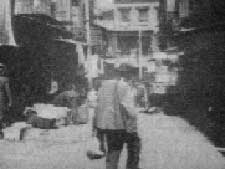 Raymond Ackerman filmed Scene in Chinatown (1900) for Biograph. It's just a quiet street scene with Chinese men & women walking & shopping, A few men's pigtails can be seen.
Raymond Ackerman filmed Scene in Chinatown (1900) for Biograph. It's just a quiet street scene with Chinese men & women walking & shopping, A few men's pigtails can be seen.
The rather official looking whites seen in the early scene, with elbows out like they think they're tough guys, are thought to be health inspectors. They're frankly very likely harrassing merchants because they so took for granted their right to do what they wanted to the Chinese that they were happy to arrange it for Alexander's Saturday filming.
The alternative identity of these whites suggests they're members of the Chinatown Squad, formed in 1875, & often raiding merchants hoping to root out illegalities but just messing stores up if there was nothing illegal to be found.
It's believed to be the corner of Tuck Wo Gai ("Virtue & Harmony Street") & adjacent Washington Street was called Wa Sheng Dun Gai ("Waystation to Prosperity Street"), known to whites as Washington Place & Jackson Street.
A year later, Ackerman's interest in things Chinese took him to Beijing & Shanghai, where he shot wartime footage, & filmed the Forbidden City in 1901.
copyright © by Paghat the Ratgirl
|
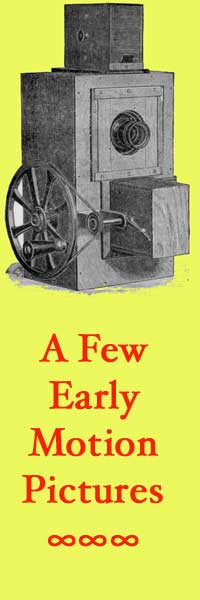
 They perform comic boxing in Dancing Boxing Match, Montgomery & Stone (1907) though only a couple seconds survive. This was a routine they worked out for a little stage play called The Red Mill produced in 1906 at the Knickerbocker Theater.
They perform comic boxing in Dancing Boxing Match, Montgomery & Stone (1907) though only a couple seconds survive. This was a routine they worked out for a little stage play called The Red Mill produced in 1906 at the Knickerbocker Theater.
 An outdoor location was found to film Capture of Trenches at Candaba (1899) in order to lend authenticity to this short-short scene of Filipino men in a trench firing & reloading rifles, then retreating from the onslaught of American soldiers with prominant flag waving oh so perfectly into the scene. The trench is captured, hoorah hoorah.
An outdoor location was found to film Capture of Trenches at Candaba (1899) in order to lend authenticity to this short-short scene of Filipino men in a trench firing & reloading rifles, then retreating from the onslaught of American soldiers with prominant flag waving oh so perfectly into the scene. The trench is captured, hoorah hoorah.
 Filmed by Alfred C. Abadie, Move On provides a very simple New York street scene, static but surprisingly action-packed. There's some close-ups & a bit of camera tracking that is advanced for the time. The "climax" is the arrival of a police officer who makes the vendors "move on" while shaking his fist.
Filmed by Alfred C. Abadie, Move On provides a very simple New York street scene, static but surprisingly action-packed. There's some close-ups & a bit of camera tracking that is advanced for the time. The "climax" is the arrival of a police officer who makes the vendors "move on" while shaking his fist. Last of all is a shot of a group from a newly arrived boat disembarking & heading for the immigration depot, that the process may continue.
Last of all is a shot of a group from a newly arrived boat disembarking & heading for the immigration depot, that the process may continue.
 Filmed that same autumn day, Horses Loading for Klondike, No. 9 (1897) with livestock on the pier & horses inside large closed boxes being hoisted onto the deck.
Filmed that same autumn day, Horses Loading for Klondike, No. 9 (1897) with livestock on the pier & horses inside large closed boxes being hoisted onto the deck.
 Return of Lifeboat (1986) by White & Blenchynden shows a boat from the Pacific Coast Life Saving Service.
Return of Lifeboat (1986) by White & Blenchynden shows a boat from the Pacific Coast Life Saving Service. Rather prettier was Parade of Chinese (1898). It captures a lively moment in Chinatown during the San Francisco Golden Jubilee. Floats, banners, & white horses are glimpsed.
Rather prettier was Parade of Chinese (1898). It captures a lively moment in Chinatown during the San Francisco Golden Jubilee. Floats, banners, & white horses are glimpsed. I could be assuming wrong but Edison was notorioius for poaching who & what he could in all spheres of the company, & Miles had a particular eye for ornateness of city streets that seems to be reflected in San Francisco Chinese Funeral (1903). So I think he was making films for both companies.
I could be assuming wrong but Edison was notorioius for poaching who & what he could in all spheres of the company, & Miles had a particular eye for ornateness of city streets that seems to be reflected in San Francisco Chinese Funeral (1903). So I think he was making films for both companies.